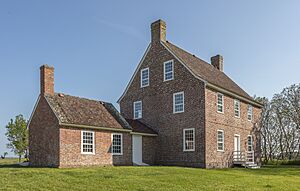Rackliffe House (Assateague State Park) facts for kids

Rackliffe House in 2022
|
|
| Lua error in Module:Location_map at line 420: attempt to index field 'wikibase' (a nil value). | |
| Established | 1752 |
|---|---|
| Location | 11700 Tom Patton Lane, Berlin, Maryland, 21811; Assateague State Park, Assateague Island, Maryland |
| Type | Historic house museum |
| Founder | Charles Rackliffe (1752); Tom Patton (2010) |
Rackliffe House is a special old house from the 1700s. It has been carefully restored and sits right by the water, looking out over Sinepuxent Bay. This historic house is located at 11700 Tom Patton Lane in Berlin, Maryland. It's also very close to the Assateague Island Visitor Center, which is part of Assateague State Park.
In the 1700s, this house was one of the most impressive homes in the area. It was built with strong bricks in a special pattern. Rackliffe House is one of the few remaining "tidewater dwellings" from colonial times. It might even be the only one of its kind from that period in the Mid-Atlantic region that you can visit today!
Contents
History of Rackliffe House
Who Lived Here First?
Long ago, the Assateague Indians lived in this area. They used the land around what is now Rackliffe House as a hunting camp. Later, in 1679, a large piece of land was given to Charles Rackliffe and his brother-in-law, Edward Wale. This land, originally called Genezeer, is the oldest property owned by colonists in Northern Worcester County.
Building the House
Captain Charles Rackliffe built the two-story house around 1752. It was made of thick bricks and had large windows. From its high spot, the Rackliffe family could see Sinepuxent Bay and the Atlantic Ocean. This allowed them to watch for ships coming and going. The kitchen was in a separate building, connected to the main house by a small hallway.
Life on the Plantation
On the plantation, African-American slaves worked to grow crops like tobacco, corn, and wheat. In 1790, records show that Charles Rackliffe owned 10 slaves, many animals, and a lot of tobacco.
Surviving Through Time
Rackliffe House has stood strong through many important events in American history. It survived the American Revolutionary War, the War of 1812, and the American Civil War. There's a local story that the top floors of the house were damaged by fire during an attack in the Revolutionary War.
In the early 1800s, the house was sold several times. Then, in 1929, a fire badly damaged the inside of the house. It was rebuilt later, and the original brick exterior was covered with white stucco. In 1996, the state of Maryland bought the house and 114 acres of land around it.
The Rackliffe House Trust
What is the Trust?
The Rackliffe House Trust was started in 2004 by Tom Patton. He was a descendant of the Rackliffe and Wale families. Tom Patton dreamed of making the house a place where people could learn about the history of the Maryland coast. He passed away in 2010, but the work continued.
Restoring the House
Before the restoration began, experts carefully studied the house and its history in 2007. The Trust now manages the house and three acres of land. They have a 50-year lease from the Maryland Department of Natural Resources. This three-acre site is part of the larger 110-acre area within Assateague Island State Park.
The Trust has worked with the Maryland Department of Natural Resources and Assateague State Park. They have raised over $800,000 to restore Rackliffe House and explore the property for historical clues. The main parts restored include the old house, its attached kitchen, and the milk house. Workers removed newer wood, rebuilt four original fireplaces, and put on a new roof that looks like it did in the 1700s. They also repaired the damaged walls using old bricks. The walls were very thick, about 18 inches at the bottom! Modern things like wiring, heating, air conditioning, and plumbing were also added.
The house first opened for public tours in 2012. More than 1,100 visitors came to see it that year.
Archaeological Discoveries
Digging for Clues
The area around Rackliffe House is a great place for archaeologists to dig. They can find clues about both prehistoric times and the early 1700s. People believe there were other buildings on the property long ago, and even a graveyard nearby. However, the exact location of the graveyard is still unknown. There are worries that some important historical sites might have been lost due to changes in the shoreline and new developments like golf courses.
What Was Found?
In 2010, archaeologists Aaron Levinthal and Ryun Papson led a three-week dig. They mapped the site by taking soil samples from 300 small holes. This helped them decide where to dig in more detail. They found that "three-quarters of the property has archaeological integrity," meaning the soil had not been greatly disturbed. Among their exciting discoveries were pieces of Native American pottery from before 1650. They also found a possible dumping ground in a swampy area and a buried brick walkway. Over 40 volunteers helped with the work at the site.
How to Visit Rackliffe House
Rackliffe House is part of Assateague State Park. The grounds are open from dawn to dusk every day of the year. Visitors can explore the outside of the house and the milk house. You should park at the Assateague Island Visitor Center. From there, you can walk to the house along Tom Patton Lane. New hiking trails are being planned to offer a more scenic path. The house itself is open for tours only on specific days during the summer.

